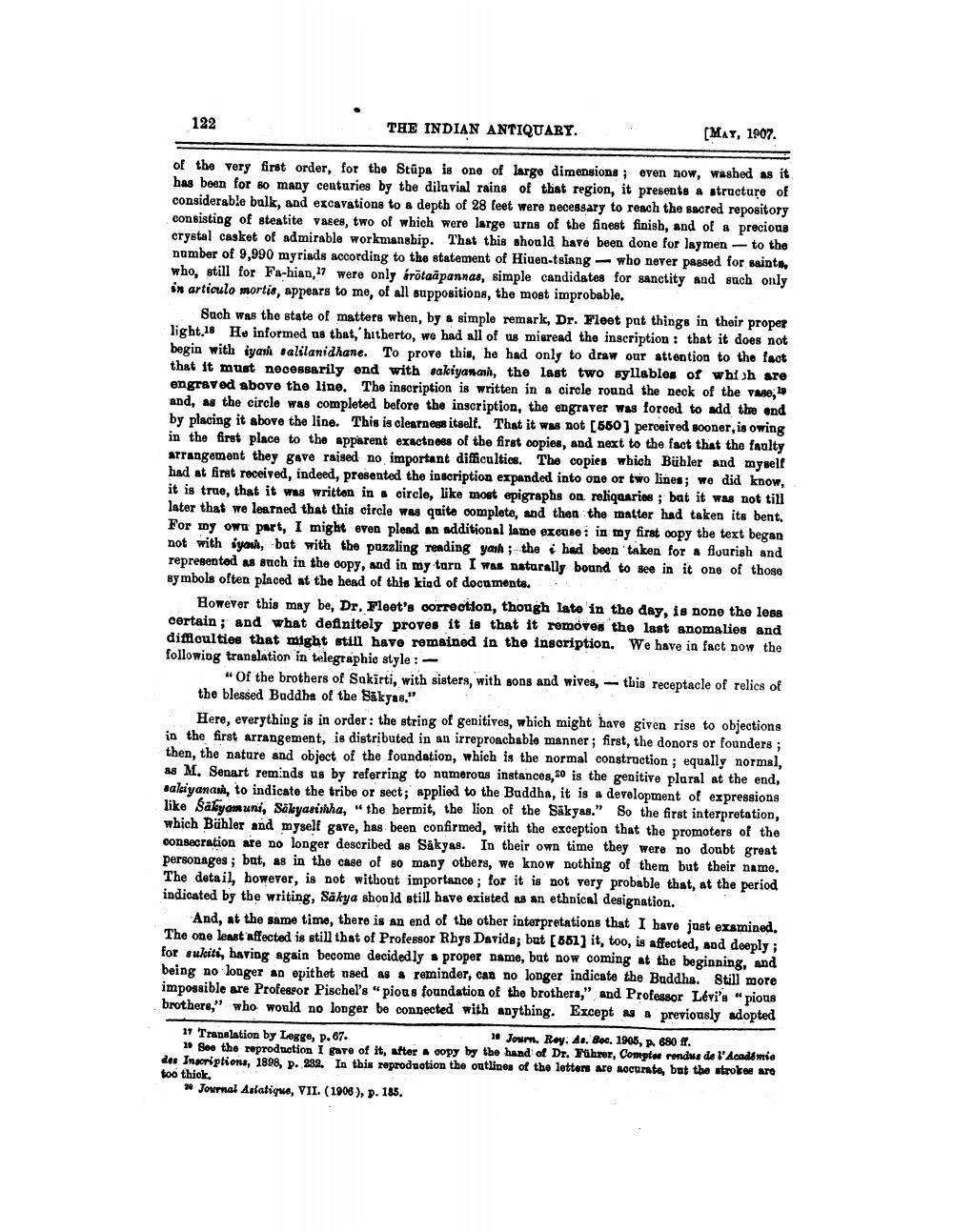________________
122
THE INDIAN ANTIQUARY.
[MAY, 1907
of the very first order, for the Stūpa is one of large dimensions ; even now, washed as it has been for so many centuries by the diluvial rains of that region, it presents a structure of considerable bulk, and excavations to a depth of 28 feet were necessary to reach the sacred repository consisting of steatite vases, two of which were large urns of the finest finish, and of a precious crystal casket of admirable workmanship. That this should have been done for laymen - to the number of 9,990 myriads according to the statement of Hiuen-tsiang - who never passed for sainto, who, still for Fa-hian, were only Srotaäpannas, simple candidates for sanctity and such only in articulo mortis, appears to me, of all suppositions, the most improbable.
Such was the state of matters when, by a simple remark, Dr. Fleet put things in their proper light 18 Hu informed us that, hitherto, we had all of us misread the inscription : that it does not begin with iyan salilanidhane. To prove this, he had only to draw our attention to the fact that it must necessarily end with sakiyana, the last two syllables of which are engraved above the line. The inscription is written in a circle round the neck of the vase, and, as the circle was completed before the inscription, the engraver was forced to add the end by placing it above the line. This is clearness itselt. That it was not (660) perceived sooner, is owing in the first place to the apparent exactness of the first copies, and next to the fact that the faulty arrangement they gave raised no important difficulties. The copies which Bühler and myself had at first received, indeed, presented the inscription expanded into one or two lines; we did know, it is true, that it was written in a circle, like most epigraphs on reliquariae ; bat it was not till later that we learned that this circle was quite complete, and then the matter had taken its bent. For my own part, I might even plead an additional lame excuse: in my first copy the text began not with you, but with the puzzling rending yash; the i had been taken for a flourish and represented as such in the copy, and in my tarn I was naturally bound to see in it one of those symbols often placed at the head of this kind of documents.
However this may be, Dr. Fleet's correction, though lato in the day, is none the less certain; and what definitely proves it is that it removes the last anomalies and difficulties that might still have remained in the inscription. We have in fact now the following translation in telegraphic style :
“Of the brothers of Sakirti, with sisters, with sons and wives, this receptacle of relics of the blessed Buddha of the Säkyas."
Here, everything is in order : the string of genitives, which might have given rise to objections in the first arrangement, is distributed in an irreproachable manner; first, the donors or founders ; then, the nature and object of the foundation, which is the normal construction ; equally normal, 18 M. Senart reminds us by referring to numerous instances, ao is the genitive plural at the end, Saliyanan, to indicate the tribe or sect; applied to the Buddha, it is a development of expressions like Sakyamuni, Säkyasinha, "the hermit, the lion of the Sākyas." So the first interpretation, which Bühler and myself gave, has been confirmed, with the exception that the promoters of the consecration are no longer described as Sikyas. In their own time they were no doubt great personages ; but, as in the case of so many others, we know nothing of them but their name. The detail, however, is not without importance; for it is not very probable that, at the period indicated by the writing, Säkya should still have existed as an ethnical designation.
And, at the same time, there is an end of the other interpretations that I have just examined. The one least'affected is still that of Professor Rhys Davids; bat [661] it, too, is affected, and deeply; for sukiti, having again become decidedly a proper name, but now coming at the beginning, and being no longer an opithet used as a reminder, can no longer indicate the Buddha. Still more impossible are Professor Pischel's "pious foundation of the brothers," and Professor Levi's "pious brothers," who would no longer be connected with anything. Except as a previously adopted 11 Translation by Legge, p. 67.
- Joum. Rey. A.. Boc., 1906, 680 ff. 19 See the reproduction I gave of it, after copy by the hand of Dr. Führer, Comptes rendus de l'Académie der Ingeriptions, 1898, p. 232. In this reproduotion the outlines of the letters are accurate, but the stroke aro too thick.
* Journal Asiatique, VII. (1908), p. 185.




